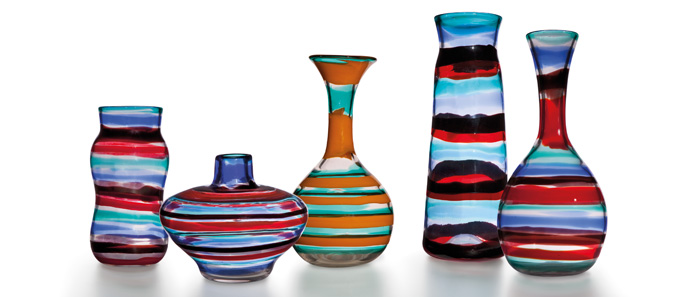
Fulvio Bianconi: artist and glass designer

Ahead of the exhibition “Fulvio Bianconi at Venini”, the Glass Study Centre of the Institute of Art History at the Fondazione Giorgio Cini,in collaboration with Le Stanze del Vetro, is staging an international conference on the island of San Giorgio to explore the work of this multifaceted artist. The aim is to provide the public with a portrait of an outstanding personality in terms of his highly varied interests and skills.
Fulvio Bianconi (Padua, 1915 – Milan, 1996) was at the same time a graphic designer, an illustrator and an industrial designer with a strong artistic background. His first contact with Murano glass was as an apprentice decorator under the guidance of Michele Pinto in the 1930s, while he was also working as a caricaturist in Milan. There he was noticed by Dino Villani, who introduced him to some of the leading publishing houses of the day. He thus began a series of collaborations as a freelance graphic artist and illustrator with publishers such as Garzanti, Mondadori, Bompiani, Rizzoli and Motta; he was also commissioned to paint a series of frescoes for the Galtrucco shops and for the pavilions at the Milan trade fair. Having joined Garzanti on a permanent basis, he remained with them until 1975. During that period he also worked for GiViEmme, FIAT, Marzotto, HMV, Pathe, Columbia, Pirelli and RAI.
In 1946, following a commission to design perfume bottles for GiViEmme in Murano, he met Paolo Venini, who introduced him to the extraordinary world of glass. Venini sensed Bianconi’s great creative potential and invited him to work in his Venetian glassworks. Their collaboration, which lasted until the mid-1950s, produced, for example, the twelve Figures from Commedia dell’Arte (shown at the 24th Venice Biennale in 1948), the Tiepolo Figures, the Mermaids, and the Pezzato and Fazzoletto vases – the latter went on to become a symbol of post-war Venice. His production conveys the lively and fertile ideas of those years and contributed to the success of Venetian glass on the international scene.
A great interpreter of the minimalist taste of the 1960s, he occasionally collaborated with leading furnaces and art galleries that were active in the glass sector, such as Gino Cenedese & C. in the 1950s, the Danese Gallery in Milan (with glass made by I.V.R. Mazzega) in 1958. In 1963 he designed for the Vistosi glassworks, and was awarded a prize at the Milan Triennial for a cylindrical vase with spiral-shaped bands. He then worked for Venini again, designing a series of Vasi Informali (c. 1967), in which he returned to one of his favourite themes – the female figure. Later on he collaborated with various other glassworks: Vetreria Ferro Galliano (1966) Seguso Vetri d’Arte (1978), Toso Vetri d’Arte (1983) and the Vetreria de Majo (1991-1992).
Fulvio Bianconi can definitely be considered as one of the most influential designers of Murano glass in the 20th century. An untiring experimenter, he constantly explored new and ancient glass-making techniques in his research and eclectic production.
